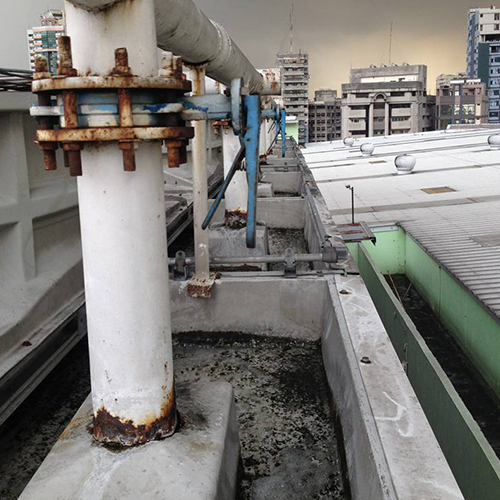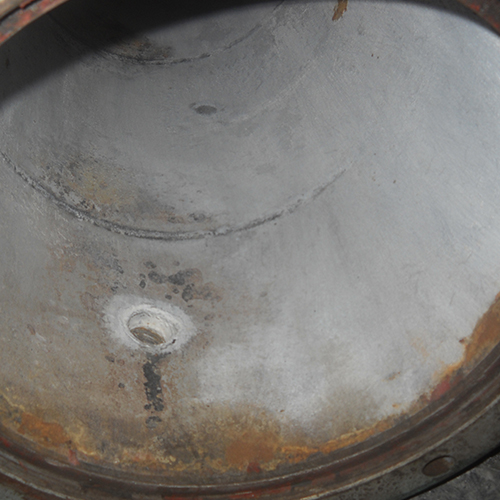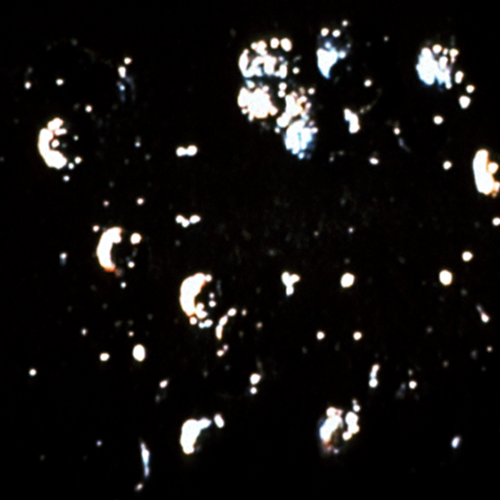Chemicals and Services
Biocide
A cooling system is an ideal environment for microscopic organisms to live. They enter the system from the air or makeup water and survive with the help of different factors. Left uncontrolled, they multiply quickly and may completely foul a cooling system in a very short period of time. There are three types of microorganisms:
- These are the most dangerous microorganisms in cooling water because they can cause the most damage.
- These require sunlight to survive and grow, so these are generally found only on open type system.
- Fungi are a group of microorganisms that use the carbon in wood fibers for food. This carbon is found in the cellulose fibers that give wood its strength.
Bacteria form sticky slime masses that foul and cause reduced heat transfer. They produces acidic waste that lowers pH and cause corrosion. They also produce large volumes of Iron deposits that foul. Also, they produce acids from ammonia that increase corrosion and lower pH.
There are four classifications of bacteria.

Slime-forming bacteria are the sticky, jelly-like organisms that grow in tower basins and heat ex changers. They secrete jelly-like substance to protect their bacteria colony. This sticky layer makes them difficult to destroy and also provides an ideal spot for other materials to become trapped. These bacteria can cause serious fouling problems in a very short time.

Iron depositing bacteria use dissolved iron as their food turning them to reddish-brown deposits. The deposits may cause fouling problems.

Nitrifying Bacteria converts ammonia into nitric acid which lowers the pH of the cooling water and causes corrosion. They need a source for ammonia in the water and are most often found in ammonia plants or breweries.

Anaerobic corrosive bacteria are the most dangerous microorganisms. A popular place for them to grow is under deposits of slime forming bacteria. Anaerobic corrosive bacteria takes nutrients and convert these to acid that may eat right through cooling system metal.

Fungi cause either surface or internal rotting of the wood. Fungi are capable of collapsing an entire cooling tower as a result of deep wood rot. They plug distribution holes on tower deck and are food for other organisms. They also consume chlorine.

Algae requires sunlight. They form “Algae Mats” and cause fouling in equipment.
Once in the cooling water, the growth of the microorganisms is affected by the following factors:
- Nutrients(Ammonia, oil and organic contaminants)
- Temperature (70°F to 140°F, acceptable range)
- pH (6.0 to 9.0, Ideal condition)
- Location (presence of sunlight)
- Atmosphere (aerobic/anaerobic)
The problems caused by bacteria, algae and fungi are different. Each one grows in a different area of the cooling water system. Microbiological growth can cause the other major cooling water problems: corrosion, scale, and fouling.
Scaling are affected by certain factors: mineral concentration, water temperature, water pH, suspended solids and water flow velocity. If there are more minerals in the water than the water can hold in solution, then scale will form. This condition is called supersaturation. As the water temperature increases, the common scale forming substances become less stable and may precipitate. As the pH of the water increases, the tendency for scale formation increases. Other suspended solids such as corrosion products or microorganisms, rough pipe surfaces or already formed crystalline deposits can seed the formation of new scale.

Our Product
Controlling microbiological growth is the key to a successful cooling water treatment program. Loss of microbio control is, in most cases, the root cause of a cooling water program failure. Good microbio control is critical. A cooling water is continually being inoculated or contaminated with microorganisms. They enter with the makeup water and are scrubbed from the air. Steps must be taken to insure that the environment they find in your cooling water is a hostile one where they will not be able to survive. The following methods can be used to control the growth of microorganisms:
- Water quality. The survival of the microorganisms depends on their finding a good food source. Steps should be taken to insure that organic contaminants that could serve as a nutrient source are minimized. Oil, grease, dust, dirt, leaves, litter and process contaminants should be kept from contaminating the cooling water. If there is no food, there will be no microorganisms.
- System design considerations. There are several considerations in system design that can help deter the growth of microorganisms. Clean sludge from tower basins regularly. Use plastic fill and mist eliminators to reduce problems with fungi. Cover tower decks to inhibit algae growth.
- Chemical treatment with biocides. A good chemical program is critical to controlling microorganisms. Three general classifications of chemicals are used for the control of microorganisms: oxidizing, non-oxidizing and biodispersants.
LCIPI offers three different biocides, a combination of non-oxidizing and biodispersant chemicals to ensure its compatibility with any material of construction of the cooling tower and heat exchanger system.
- Hydralchem HC-108A
- Hydralchem HC-108B
- Hydralchem HC-108C
Combination of any two of these three available biocides are recommended depending on the condition of the cooling tower. The technical team critically and accurately determines the combination of biocides tailor-fit for the cooling tower condition, so that microorganisms do not become resistant to a single type of biocide. LCIPI Chemicals and Technical Services Division ensures proper monitoring and control for effective application of its biocide program.

